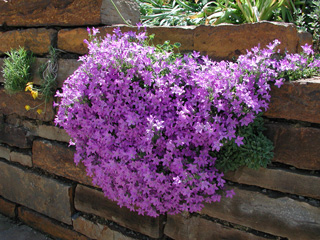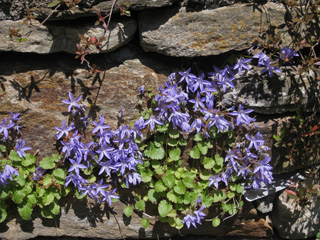Resource Library
Plant of the Week: Bellflower, Trailing

This trailing bellflower in a Kansas City garden makes me want to grow them but they don’t seem to appreciate our hot nights. (Image courtesy Gerald Klingaman)
Download High Resolution
Plant of the Week
Trailing Bellflower
Latin: Campanula sp., bellflower
It is human nature to want what you can’t have. Though I love bellflowers (Campanula), my experience with them has been that of a forlorn lover. You love them a while and then they are gone. Gardeners in the northern states curse some for being weedy, but in the south where our warm night temperatures beat them into submission, they are fleeting in most gardens.
Over the years I’ve tried to grow several of the trailing or groundcover type bellflowers but have found most of them short lived in my Fayetteville gardens. It might be worthwhile to discuss my experience with them in a warm climate.
There are over 300 species of Campanula native in the northern hemisphere with one, the tall, summer flowering C. americana, native to the northern half of Arkansas. Most campanula though are native to high elevation sites or in northern latitudes where they are often associated with alkaline soils. The trailing or groundcover kinds are from mountainous sites around Europe.
Campanulas belong to the bellflower family and are herbaceous perennials with bell shaped, usually nodding, blue or purple flowers. They range in growth habit from 6-foot-tall upright growers such as our native tall bellflower to prostrate creepers. As a rock garden fan, I’ve mainly tried to grow the small creeping types such as C. poscharskyana (Serbian Bellflower), C. portenschlagiana (Dalmatian Bellflower), and C. carpatica (Carpathian Bellflower).

Bellflowers add beautiful shades of blue to the spring rock garden and flower border. (Image courtesy Gerald Klingaman)
Download High Resolution
The foliage is mostly evergreen and typically held close to the ground in a loosely organized crown. Plants creep about and can produce colonies several feet across if the site is to their liking. Late spring flowers of the Serbian and Dalmatian bellflowers are five-petaled, star-shaped and nodding but on erect or pendant panicles. The Carpathian bellflower has upward facing bowl shaped flowers that, in their most common forms ‘Blue Chip’ and ‘White Chip’, have blue or white flowers.
Though most gardeners report them as being “rampant and easy to grow” my experience with all of the creeping bellflowers here in my zone 6/7 garden can only be classified as a failure. I’ve tried them in planting crevices in a rock wall and between flag stones along a well drained garden path. I certainly haven’t tried all of the cultivars in all the possible planting nooks, but I’ve never succeeded in keeping any alive more than two years.
Their preference is for bright, moist but never wet, sites that are relatively cool. Achieving the right balance of moisture and drainage, especially during the heat of summer, is difficult. I’ve read that these species don’t do well when night temperatures routinely exceed 70 degrees Fahrenheit, an all too common experience across much of the state. And then if you make it through the summer and the winter season is a wet one, they can again fail to survive the winter.
Though my success has been questionable, I’m a slow learner and want to try a couple new selections to make sure I’m right. ‘Blue Waterfall’, newly introduced plant in 2002 from England did well in the Chicago trial and is reported to establish well in dry shade in North Carolina, is on my shopping list and will hopefully live up to its billing.
By: Gerald Klingaman, retired
Extension Horticulturist - Ornamentals
Extension News - May 19, 2014
The University of Arkansas System Division of Agriculture does not maintain lists of retail outlets where these plants can be purchased. Please check your local nursery or other retail outlets to ask about the availability of these plants for your growing area.